If you are looking for the best China tours for seniors, then I strongly recommend this 10-day China tours for seniors to you. From the energetic Shanghai to enchanting Sanya and the capital Beijing, it is a slow-paced China tours for seniors that provides you with the most spectacular and impressive views of this ancient kingdom. In Shanghai, up to the highest building in China – Shanghai Tower, you will witness the fast development of this international metropolis; in Sanya, you will be surrounded bytropical coastal landscapes; in Beijing, you will be told the secrets hidden in the ancient imperial palace. This well-designed 10-day China tours for seniors will never disappoint you. Come and join us!

Today your 10-day China tour begins from Shanghai. Upon landing in Shanghai, your private tour guide will give you a warm welcome at the arrival hall of the airport and then transfer you to the comfortable hotel for a good rest.
Shanghai is located at the confluence of the Yangtze River and Huangpu River and is part of the Yangtze River Delta. Shanghai is the largest city in China and the eighth-largest city in the world. It is one of the four municipalities directly under the Central Government of China, which includes Beijing, Tianjin, Shanghai, and Chongqing. According to the latest statistics in 2020, there is a permanent population of over 24.87 million living in Shanghai. In the old days, Shanghai was just a small town dominated by fishery and cotton textile handicrafts. Since the 1930s, Shanghai has become a hub for multinational companies to carry out international trade, known as the “Paris of the East”. With the Reform and Opening Up policy, Shanghai has developed rapidly and become China’s largest economic center and the world’s largest trading port.
This morning you will begin your Shanghai trip by exploring Yu Garden(closed each Monday).
Yu Garden is the only Ming Dynasty (1368-1644)style garden in downtown Shanghai, and it is known as the “Top of the Five Gardens in the Regions South of the Yangtze River” with a history of more than 400 years. The Yu Garden was built by Pan Yunduan, Governor of Sichuan in the Ming Dynasty, in order to allow his father Pan En to enjoy his twilight years. However, the construction lasted for 28 years and was finally completed in 1577 when his parents passed away without seeing this garden. What a pity! In the garden, you will see a rockery, 12 meters high and weighing 2,000 tons. It is one of the essences of the Yu Garden landscape. It was meticulously designed and piled up by Zhang Nanyang, a famous rockery landscape architect in the Ming Dynasty, and is his only surviving work in China. As the oldest, largest, and most exquisite existing rockery in South China, it enjoys the reputation of “Top of the Rockery in South China”.
Then you will come to Jade Buddha Temple for a visit. It is a well-known Buddhist temple and one of the Top 10 tourist attractions in Shanghai. Although it is located in a prosperous urban area, it is hailed as a piece of “pure land in downtown”. For the origin of the Jade Buddha Temple, there is a folktale. When Shanghai International Settlement, home to many Americans and British in Shanghai at that time, was constructed in 1882, a stone stele carved with rune-like patterns was dug out from the underground. Subsequently, a plague broke out and many people die. At that time, Monk Huigen from Mount Putuo, who was on his way back to Mount Putuo from Burma with 5 jade Buddha statues, was passing by Shanghai. Seeing this situation, he said that this stone stele was not auspicious. Therefore, Monk Huigen hosted a sacrificial ritual and buried the stone stele underground. Then he left two jade Buddha statues here and built a temple to suppress the evil, which is the Jade Buddha Temple now. It is said that the stone stele is still under the temple.
After lunch, you will go to Shanghai Tower to admire the panorama of Shanghai. With a total height of 632 meters, Shanghai Tower is currently the second tallest skyscraper in the world, second only to the Burj Khalifa in Dubai. The 632-meter high Shanghai Tower, the 492-meter high Shanghai World Financial Center, and the 420-meter high Jinmao Tower together compose a golden triangle in Pudong Lujiazui Financial Zone, which outlines a new skyline of Shanghai. Shanghai World Financial Center is about 70 meters higher than Jinmao Tower, and Shanghai Tower is 140 meters higher than Shanghai World Financial Center. The heights of the three skyscrapers visually form a perfect ascending curve, symbolizing that Shanghai is climbing up step by step and also indicating Shanghai’s ambition to become an international financial center.
Then follow your guide to go across the Huangpu River to the Bund. The Bund is located at the confluence of Shanghai’s mother river–Huangpu River, and Suzhou River, facing Lujiazui Financial Zone with majestic high-rise buildings across Huangpu River. In 1844, the Bund was designated as a British concession, becoming the starting point of modern Shanghai. At the early stage, the Bund was a center of foreign trade, where there were many foreign trade firms booming. In the late 19th century, many foreign banks were established on the Bund which became Shanghai’s “Financial Street” and was also known as the “Oriental Wall Street”. The Bund, although small in area, has gathered 52 buildings of different styles, such as Gothic, Romanesque, Baroque, and Chinese-Western style. Architects from various countries have shown their talents here. That’s why it has been known as the “Universal Expo of Architectures”. Now the Bund has become an iconic landscape in Shanghai, and it is also a must-see for tourists visiting Shanghai.
Then your guide will lead you to Nanjing Road for sightseeing and shopping. Nanjing Road is the most prosperous commercial pedestrian street in Shanghai. It starts from the Bund in the east and ends at Yan’an West Road in the west. It is divided into east and west sections by Tibet Middle Road. There are more than 1,200 well-known brands gathering here, honored as “The First Pedestrian Street of China”. However, the former Nanjing Road had nothing to do with a commercial street before. It used to be called the “Big Horse Road” which was the road for horses. During the British concession period, there was no road at first. Because the British liked riding horses, a road trodden by the horses was called “horse road”. In 1848, Shanghai’s earliest racecourse park was built on the nearby Henan Road, and the newest horse road in Shanghai appeared from the park to the Bund at that time. Later, due to high land prices, two racecourses were built one after another on the current Tibet Road and at People’s Square.Therefore, this horse road continued to extend westward, and the 5 kilometers long “Big Horse Road”from the Peace Hotel to Jing’an Temple was born.
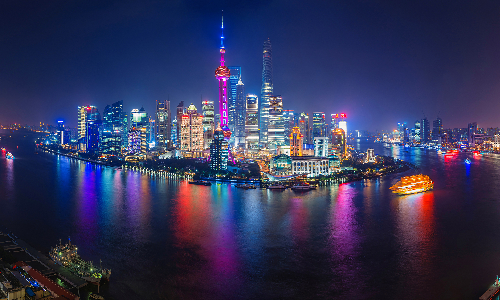
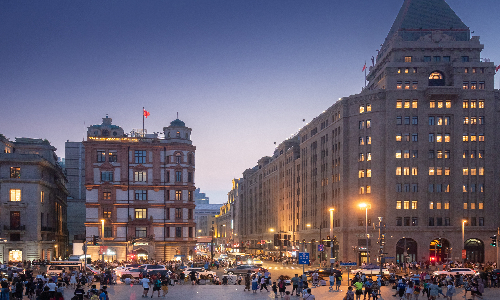
 Hangzhou
Hangzhou Shanghai
Shanghai After breakfast at the hotel, you will be driven to Hangzhou, about 180 kilometers away from southwest Shanghai. It takes about 3 hours to drive there. Hangzhou is one of the most attractive tourist destinations for senior tourists at home and abroad. As a popular Chinese saying goes, “there is a paradise in heaven while there are Suzhou and Hangzhou on earth.”
Upon arrival, you will go to West Lake, which embodies the beauty of Hangzhou. Seen from afar, West Lake is like a piece of green jade shining in the sunshine. There is a beautiful legend about West Lake. Once upon a time, Jade Dragon and Golden Phoenix from heaven found a piece of jade on a fairy island in the Heavenly River. They found that the jade was magical and they could get what they wanted with the jade. Later the news spread to the Heavenly Palace, and the Heavenly Queen Mother sent heavenly soldiers to get the jade. After the jade was robbed, Jade Dragon and Golden Phoenix rushed to the Heavenly Palace and fought with Heavenly Queen Mother. Accidentally, the jade dropped on the earth and turned into a mirror-like lake, which is the West Lake. Taking a West Lake boat for sightseeing is the best way for senior tourists to admire the beautiful scenery of West Lake. Looking at the shimmering lake with the breeze caressing your cheeks, you will be extremely relaxed mentally and physically.
After finishing your lunch, you are going to Six Harmonies Pagoda. The Six Harmonies Pagoda is located on Yuelun Mountain on the north bank of Qiantang River in Hangzhou. Together with Baochu Pagoda, Leifeng Pagoda, and White Pagoda, it is known as one of the Four Ancient Pagodas in Hangzhou. Regarding its origin, a legend has been circulating among the people. In ancient times, a dragon king with an irritable temperament lived in the Qiantang River. He was moody and often made floods that inundated houses and fertile fields along the river. The people along the river suffered a lot. Later, a young man named Liuhe led the people to fill the Qiantang River with stones. Finally, the dragon king surrendered and promised never to do evil again. Then, the people there had good harvests every year and lived in peace and contentment. In order to commemorate this brave young man, the later generations built the Liuhe(Six Harmonies) Pagoda at the site where Liuhe filled the river.
The last attraction of your Hangzhou tour is the Dragon Well Tea Plantation. If West Lake represents the natural beauty of Hangzhou, then the Dragon Well Tea represents the profound cultural connotation of Hangzhou because tea culture is an important part of Chinese culture. As early as the Tang Dynasty (618-907), the area around the West Lake was famous for producing tea. The name “Dragon Well Tea” began to be used in the Song Dynasty (960-1279). In the Ming Dynasty (1368-1644), West Lake Dragon Well Tea was listed as a famous tea of China. When Emperor Qianlong of the Qing Dynasty (1636-1912) visited West Lake in Hangzhou, he highly praised West Lake Dragon Well Tea. Since then, West Lake Dragon Well Tea had officially become a tribute to the Qing imperial family, ranking first among Chinese famous teas. Now, West Lake Dragon Well Tea is presented as a national gift to foreign leaders and ambassadors who visit China. It has become a national business card for foreigners to understand China.When you come to the tea plantation, drinking a cup of West Lake Dragon Well Tea and appreciating the history and culture behind it will be the most essential experience. Furthermore, it’s also a tasteful present for your family and friends.
After visiting the Dragon Well Tea Plantation, we will drive back to Shanghai.
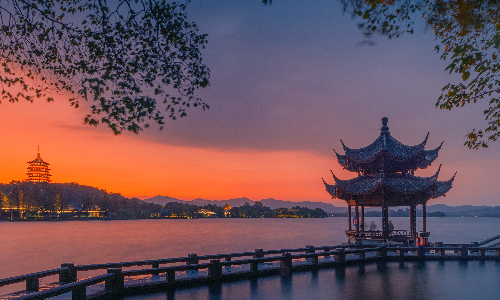
 Sanya
Sanya Today you will leave for Sanya by taking the estimated flight HU7322 11:10/14:30. Your tour guide will pick you up at the airport and transfer you to the hotel.
Located at the southernmost point of Hainan Island, Sanya is the southernmost tropical coastal tourist city in China, presenting the most beautiful coastal scenery on the island. It ranks first among China’s Top Four Coastal Tourist Cities including Xiamen, Qingdao, and Dalian, known as the “Oriental Hawaii”. It is also the city with the best air quality and the longest life expectancy in China (average life expectancy of 80 years). According to the Research Report on China’s Livable Cities, Sanya ranks third among 40 cities across the country.
This morning, you will go to Dadonghai Scenic Area for relaxing. Dadonghai Scenic Area is located in the eastern suburbs of Sanya, 3 kilometers away from Sanya Town. It is one of the famous beaches in Hainan and has been rated as one of “China’s Forty Best Tourist Attractions” by the National Tourism Administration. Dadonghai Scenic Area is surrounded by mountains on three sides and faces the sea in the south. There is a crescent-shaped bay and vast crystal clear sea water. The flat white sand beach, bright sunshine, transparent blue seawater, and lush green coconut groves constitute a beautiful tropical scenery. And in winter, the water temperature is 18 degrees Centigrade (64 degrees Fahrenheit). It is an ideal winter resort for senior tourists to escape the cold, where they can go winter swimming and enjoy sun bathing. It is also a heaven for tourists who are keen on water sports, such as diving, swimming, surfing, motorboat riding, and so on.
After lunch, Luhuitou Scenic Area is the next attraction you will visit. Luhuitou Scenic Area is located 3 kilometers south of Sanya and is the southernmost mountain on Hainan Island. This mountain with a height of 275 meters faces the sea on three sides. There is also a beautiful legend about its name “Luhuitou” (Deer Looking Back). A long time ago, there was a brutal chieftain who wanted a pair of precious deer horns and forced AHei, a young man of the Li nationality, to hunt and kill a deer. Once when AHei went hunting in the mountains, he saw a beautiful sika deer that was being chased by a leopard. AHei shot the leopard to death with an arrow, and then chased after the deer for nine days and nights and over ninety-nine mountains. Finally, they came to the mountain cliff south of Sanya Bay. Facing the vast South China Sea, there was no way for the deer to escape. At the moment when the young hunter was about to shoot the deer with arrows, the deer suddenly looked backwith tears in its eyes and then turned into a beautiful young girl. AHei fell in love with the young girl at first sight. To repay AHei for not killing her, the girl married AHei. Then they settled on the mountain, gave birth to children, and built this place into a beautiful Li nationality manor. From then on, this mountain has been called “Luhuitou”. At present, a beautiful park has been built on the top of Luhuitou, and a giant statue of 12 meters high, 9 meters long, and 4.9 meters wide has been sculpted on the mountain according to the beautiful legend. That’s why Sanya is also known as the “Deer City”. Ascending to the top of Luhuitou, tourists can have a panoramic view of Sanya.
Then you will go to the most famous market of Sanya–The First Market. Sanya boasts three “good”– good weather, good sea, and good seafood. There is a saying goes, “One who doesn’t taste seafood in Sanya has never been to Sanya.” As the preferred place for buying seafood, The First Market features fresh, cheap, and full-range seafood. The most recommended seafood is Hele crab (a kind of crab unique in Hainan), lobster, grouper, and abalone. After buying seafood in the market, you can find many processing stores nearby to have your seafood done. It’s much more economical than eating in a restaurant. In addition to seafood, you can also taste a lot of Hainan’s special snacks here, such as Hainan noodles, Qing Bu Liang (cold coconut soup mixed with various grains and fruits), glutinous rice cakes, coconut rice, as well as a variety of fresh fruit juices, etc.Tasting delicious seafood while drinking the cold Qing Bu Liang will be the most unforgettable experience of your Sanya trip.
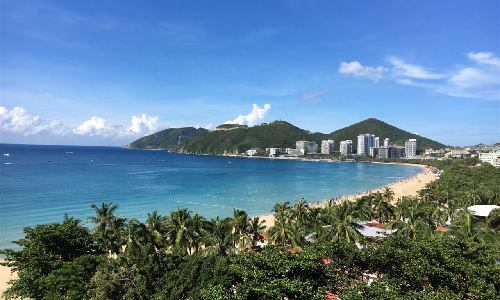
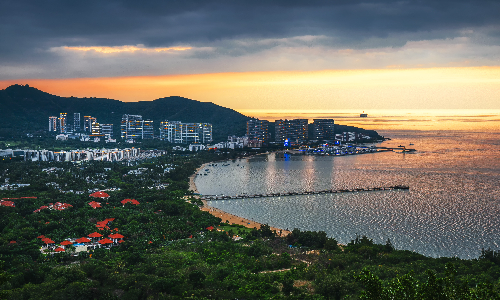
Today you will explore Wuzhizhou Island for a whole day. Wuzhizhou Island is located in Haitang Bay of Sanya. It looks like a heart-shaped island overlooked from the sky, so it is also known as “Lover Island”. The small island has an area of less than two square kilometers, but it condenses all the essence of Sanya’s coastal scenery. It is the first choice for sightseeing, diving, and sea entertainment, and has been honored as “China’s Maldives”.
Wuzhizhou Island has a vegetation coverage rate of 90%. The east, south, and west sides of the island are lush with more than 2,700 native plants. Among them, there is not only the Cyathea Spinulosa, a kind of fernthat has been living on the earth since the Age of Dinosaurs but also the Dracaena Draco, the oldest plant surviving on the earth, known as the“God of Longevity in the Plant Kingdom”.
The sea around the island with a visibility of 27 meters, and rich coral and fish species, is very popular for diving. Deep into the sea, tourists can enjoy the surrounding colorful corals and fishes. Besides, combining with its unique natural conditions, Wuzhizhou Island introduces advanced international equipment of sea entertainment to create a one-stop and all-around island tourism resort. Its high-end items such as parasailing, motorboat, and airship will bring fast and furious experiences to the tourists. For senior travelers, admiring the beautiful sea view while taking a stroll along the soft beach is also a very good way to explore the island.

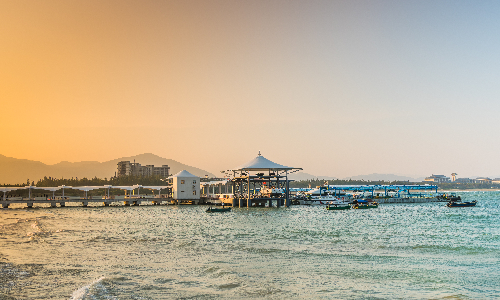
 Beijing
Beijing Today you will say goodbye to Sanya and take the estimated flight MF8394 12:25/16:45 to Beijing. After landing, your Beijing tour guide will greet you at the airport and transfer you to the hotel for a nice rest.
Beijing is the capital of China, as well as Chin’s political and cultural center. Beijing is located on the northwestern edge of the North China Plain, surrounded by Hebei Province, and adjacent to Tianjin in the southeast. It covers an area of more than 16,000 square kilometers. According to the seventh national population census in 2020, there is a permanent population of 21,893,100. With a history of more than 3,000 years, Beijing together with Xi’an, Luoyang, Kaifeng, Nanjing, and Hangzhou, is collectively known as the Six Ancient Capitals of China.
After finishing your breakfast at the hotel, you will go to the largest city center square in the world –Tian’anmen Square. During the founding ceremony of New China on October 1st, 1949, the first national flag was raised here. Since then, the solemn national flag-raising ceremony has been held every day. The ceremony is divided into the festive flag-raising ceremony and the usual flag-raising ceremony. The festive flag-raising ceremony is carried out on New Year’s Day, Spring Festival, International Labor Day, National Day, and the 1st of each month. During the ceremony, a national flag guard team of 38 Armed Police members march to the national flag pole in the north of the square. Then the flag-raising ceremony begins with the live national anthem played by a military band of 62 members. The national flag will reach the highest point of the flag pole with the end of the music. At that time, all members stop their actions, which seems like time froze.The flag-raising ceremony at Tian’anmen Square has become a must-see for tourists visiting Beijing.
Then walking through the Tian’anmen Gate Tower and the Meridian Gate, you will come to the Forbidden City(closed each Monday). The Forbidden City is located in the very center of Beijing. It was the imperial palace during the Ming and Qing dynasties, where 24 emperors once lived here. It has a history of more than 600 years since its completion.
Beijing generally enters into flood season in June every year. However, the Forbidden Cityhas rarely suffered from floods for over 600 years. An important reason why the Forbidden City has survived so far is its scientifically designed drainage system. The roofs of the palaces in the Forbidden City are all sloped roofs, which makes rainwater falling on the roofs flow down quickly to the ground. The overall terrain of the Forbidden City is higher in the north and lower in the south. The ground level at the Gate of Devine Might at the northernmost end is about two meters higher than that of the Meridian Gate at the southernmost point, forming adrainage slope from north to south. Meanwhile, the palace complex along the central axis, as the core of the Forbidden City, makes its overall terrain higher in the middle and lower on both sides, and the southwest is slightly higher than the southeast. In this way, rainwater will flow from north to south, from the middle to both sides, and finally, flow to the southeast exit. The drainage system of the Forbidden City embodies the infinite wisdom of ancient Chinese craftsmen. Many of these measures have still been used for flood control of modern buildings.
After lunch, we are going to the imperial garden of the Qing Dynasty –Summer Palace for sightseeing. The Long Corridor, Longevity Hill, Pavilion of Buddhist Fragrance, Cloud-Dispelling Hall, Kunming Lake, and the Seventeen-Archway Bridge are the major landscapes of the Summer Palace. Senior travelers are recommended to take a dragon boat to have a better sightseeing experience with less walking. Sailing on Kunming Lake, you will see the highest building afar on the top of Longevity Hill. That is the Pavilion of Buddhist Fragrance. There is a story about this building. When Emperor Qianlong ordered to build Qingyi Garden (the predecessor of the Summer Palace), the original Pavilion of Buddhist Fragrance was modeled on the design of the Six Harmonies Pagoda in Hangzhou, but the height of the pavilion was designed to be 2 floors higher than the Six Harmonies Pagoda (7 floors high). What made people puzzled was that the pavilion accidentally fell down when the eighth floor was built, only leaving the bottom three floors.At the same time, the Glazed Tile Pagoda in construction at Beihai(Today’s Beihai Park in Beijing) was destroyed by an unexplained fire. Accidents in two places happened at the same time. Emperor Qianlong thought that this was a warning from heaven for he was doing a lot of construction work, so he stopped rebuilding the pavilion. The Pavilion of Buddhist Fragrance then became what you see today.
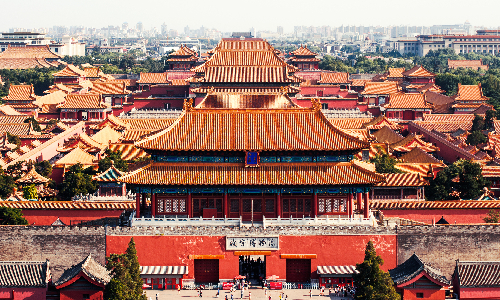
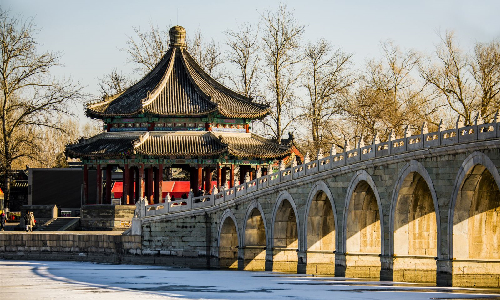
This morning, we will drive north for 2 hours to the Mutianyu Great Wall. It is nearly 80 kilometers away from downtown Beijing. It is the best-preserved section with cable cars, especially friendly to senior people. In history, the Great Wall was the greatest military defense system in ancient China. It is a tall, sturdy, and continuous long wall that is used to resist the invasion of the northern nomads. The vastness of the project is unheard-of both in ancient and modern times. Without using mechanical equipment thousands of years ago, it could be said that such a large-scale project was constructed with lives. Millions of laborers were forced to build the Great Wall and numerous people died of overwork, starvation, or illness. These dead people were buried directly in the Great Wall. When some sections collapsed, some nearby villagers could find lots of human bones. Therefore, the Great Wall is also known as the longest cemetery in the world.
Back to the downtown from the Mutianyu Great Wall, a Hutong tour by taking a rickshaw will round off your tour in Beijing. You will go to the old alleyways (Hutong) of Beijing to see what the traditional life of the Beijingers is like, which is very popular among senior tourists. Through different Hutongs by rickshaw, you will see some people are playing Chinese chess, some are taking a walk with their birds, and some are just chatting leisurely. Following your tour guide, you will go deep into a local family to know about the history of this family. Maybe there was a member in this family once working for the emperors in the Forbidden City.
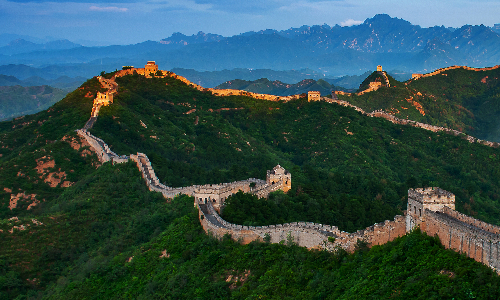
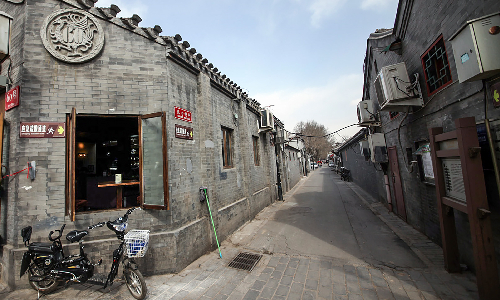
Today you will go back to your country by plane. You will be transferred to the airport with the company of your tour guide according to your flight. Then you will say goodbye to Beijing and board the return plane. Your 10-day China tour ends here.
Author: Lingyun Zhou
Proofreader: Summer Hou
| City | Five Star hotel list | Four Star hotel list |
|---|---|---|
| Shanghai | Ocean Hotel Shanghai | Courtyard by Marriott Shanghai Central |
| Sanya | Grand Hyatt Sanya Haitang Bay Resort and Spa | Hilton Garden Inn Sanya |
| Beijing | Sunworld Dynasty Hotel Beijing Wangfujing | Sunworld Hotel Wangfujing |
 |
![]() About your child or infant, please contact us for a discounted price.
About your child or infant, please contact us for a discounted price.



We started with a few days in Beijing & ended in Shanghai, from where we visited the Forbidden City and Great Wall. In between we visited Terra Cotta Warriors Museum, Panda Base, Shanghai Disneyland.

We had a wonderful holiday in China which will remain long in the memory. China is a breathtakingly beautiful country full of splendid temples and palaces, mountains and rivers, peaceful rural scenes and bustling shopping streets.
 QUICK ENQUIRY
QUICK ENQUIRY